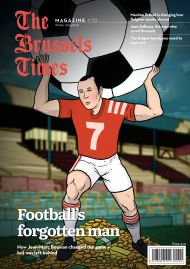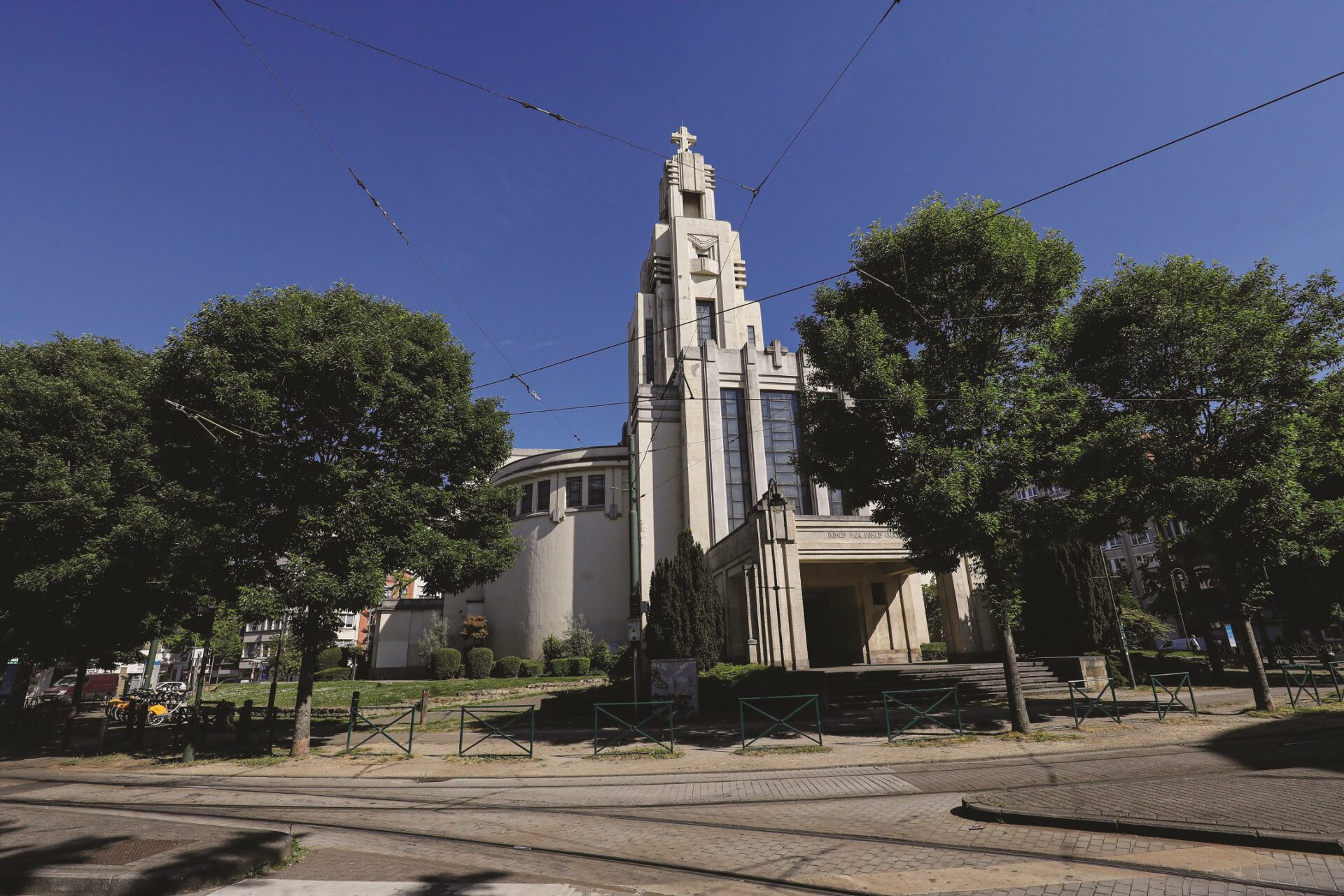In order to access the new, or rather revived, tram 18 I need to descend underground at the Bourse and alight Premetro 3.
On a grey day, I take a look around the now blessedly traffic-free Boulevard Anspach. I recall the interminable mess which blighted this part of town as they dug the tram tunnels back in the 1970s. Then, after what seemed like a decade, all was finished and the internal combustion engine reestablished its ascendency.
Now there are park benches, horse-trough-shaped flower beds, and street food carts popping up all over the place. Even on this overcast Monday relaxed crowds are enjoying the relatively clean air down to Place de Brouckère. And of course, the Bourse is now a major attraction.
But I must descend. All is new and shiny underground at the Bourse station. I am stymied at the get-go, however, as my pre-metro tram is signposted, yes, but without any indication of which platform I must take. I press on realising there is only one platform giving access in both directions! Indication of this above might help the timorous and easily bewildered!
The premetro passes the predictably vast and busy Midi Station and the Parvis St Giles/Sint Gillis Voorplein before finally to Albert, the new tram 18’s starting point. The station itself, which is set, someday, to become the southern terminus of the new Metro 3 line, has two tunnelled platforms which do not face each other. It also has a permanent photography exhibition vaunting the many delights of Forest/Vorst.
The 18 awaits upstairs but still underground. It was originally launched in 1968 between Heysel and Fort Jaco but was cancelled in 1993. It was relaunched this August, taking the southern part of the tram 51 route. At just 5km, it is the shortest route on the tram network.
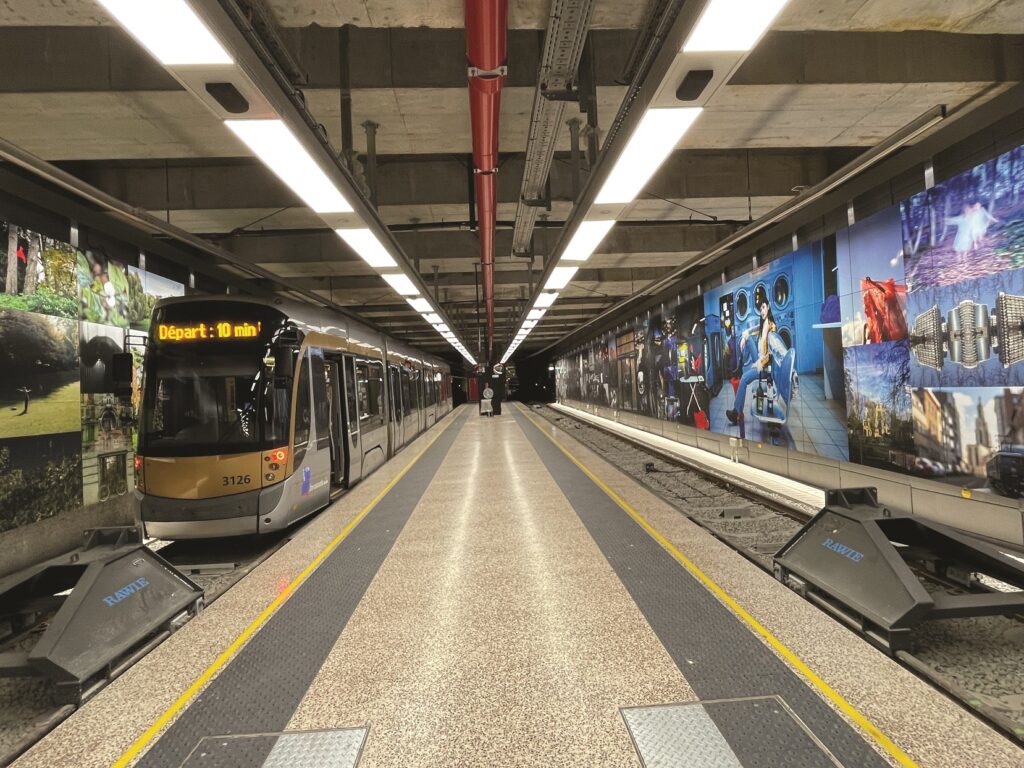
The start of the journey, the newly redone Albert pre-metro station
When the 18 departs Albert, it emerges into the grey late-October gloaming (Jupiter) with two enormous parks on the right. They are contiguous but of very different character.
Parc Duden is steep, with the Union Saint-Gilloise football stadium, a castle house, and a film school and is densely forested. This is hardly surprising as it is a remnant of the Sonian Wood and has records going back to 1106 when it belonged to an Abbey.
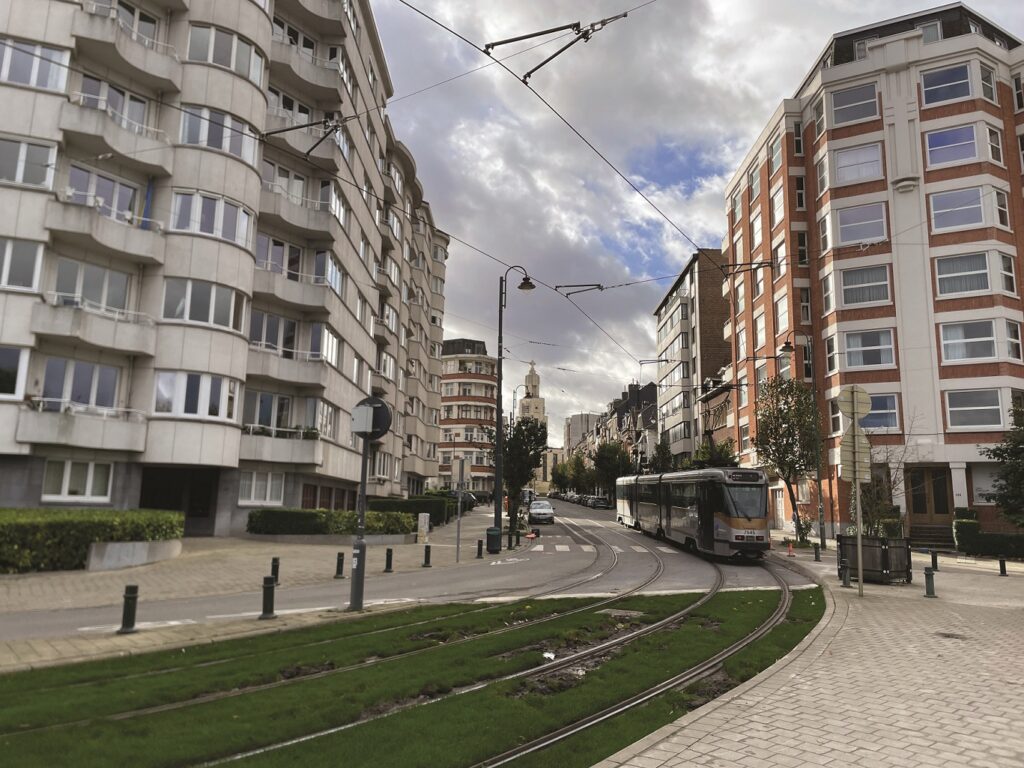
Emerging on to Avenue Jupiter, and heading towards Altitude Cent
It is easy to get lost in (I did) and has that most Brussels of institutions - well, in the summer anyway - a “guingette”. This is defined as an open-air, pop-up café where dancing is encouraged. What could be more delightful? All gone in October, of course, but I was compensated somewhat by an apposite poem by Armand Barnier (1902-1969) engraved in stone nearby which translates as:
Birds make the forest ring
Birds make the waters dance.
So all who sing and dance
Have the soul of a bird.
The smaller green space, right next door, is Forest Park, named after the commune. In fact, it was converted from farmland owned by the royal family and is much more open. Leopold II, who had a hand in its design (he must have driven city planners nuts!), insisted that the Palais de Justice law courts - his pride and joy - should be visible from all points there. As an unintended consequence of this, the park saw active duty as a city observation point during the First World War.
Incidentally, Visitbrussels.be claims that Brussels is some 50% parkland. A quick look at the map shows that that is clearly not the case. They may have, erroneously or by design, included private gardens and/or that part of the Sonian Forest not inside the city. World Cities Culture Forum records that Brussels has a respectable 18% of green public space, ahead of Amsterdam and Austin, but about half of Edinburgh, Hong Kong and Singapore.
Art Deco church
One stop further, in the middle of an eight-armed summit roundabout (Altitude Cent/Hogte Honderd) is the slightly unreal Church of Saint Augustine or Église Saint-Augustin. It resembles nothing so much as an Art Deco hotel in Miami Beach, at least if you ignore the cold and the drizzle. It was designed by iconoclast François Guianotte.
Unfortunately, the quality of the concrete used at the time, the 1930s, was not up to his dreams. Thirty years after completion it started to degrade and narrowly escaped demolition. It was fully restored in the late 1990s. It is said the interior is more conventional with stained glass windows, religious statuary and a traditional pulpit. This one must take on trust as all was locked and shuttered, with no sign of recent human activity, when I shook the door.
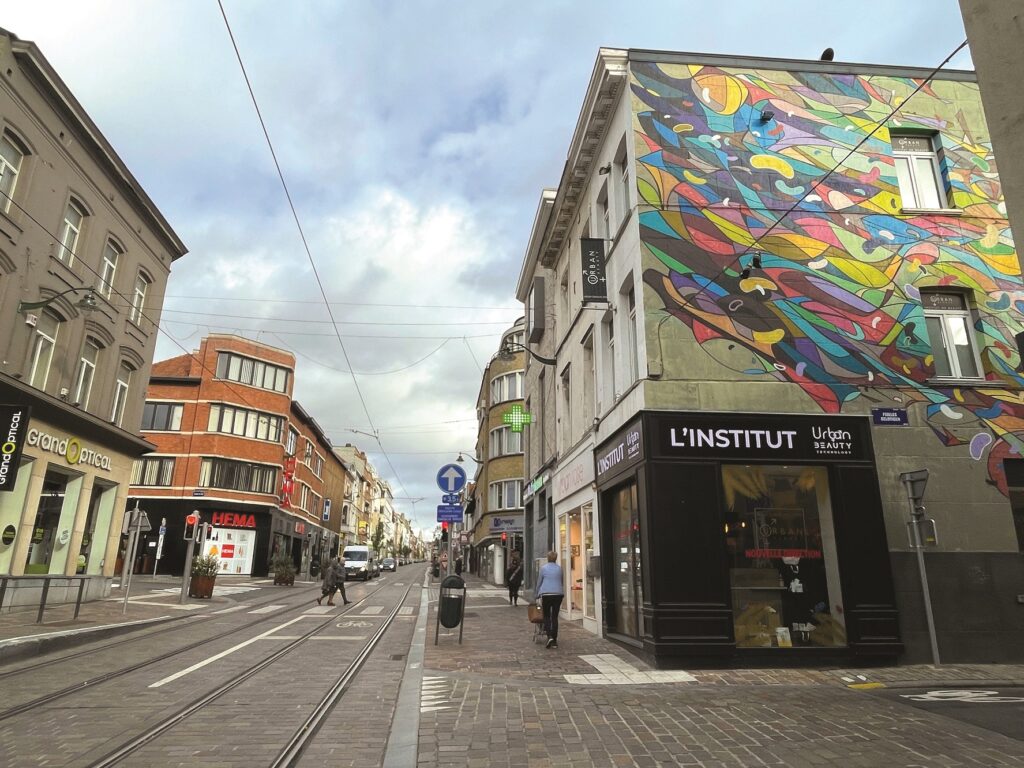
The route starts and finishes on the Chaussée d’Alsemberg, above, but does not always follow it
The tram then heads down the altogether unromantic Chaussée d’Alsemberg/Alsembergsesteenweg. Narrow and descending the 100 metres we have just climbed - not the Himalayas I grant you but in Brussels, you take your peaks where you find them - the road flanks us with betting shops, laundrettes, the Imprimerie Tournaisiene, and a superette quirkily called Peppermint Park after a kids’ TV show!
A welcome relief is a Lidl, halfway down, housed in a (I’m guessing) converted bank which would have comfortably graced Ancient Rome. But I long for some flash of urban distinction and suddenly there it is (Xavier de Bue). Off to my left, 100 metres down a busy crossroad, is an 18th-century, red brick church.
Parvis Saint Pierre/Vorplein Sint Pieters is a little gem. In the middle of it stands the eponymous church, featuring a west-facing frontage of red brick and bluestone, an octagonal belfry, and a handsome clock. Research confirmed my assessment from the tram; it is indeed 18th century. Inside all is clean, warm and welcoming.

Parvis Saint Pierre
Notices pinned on boards betoken an active community; confirmed by the well-designed website. A couple of noble looking paintings with religious motifs hang on the north wall and a large bouquet of flowers, fresh cut - I touched them gently to be sure - stand in front of the altar. Ultra-modern glass doors enhance rather than detract, and keep in the warmth.
The surrounding square is of a piece. The church is within spitting distance of upmarket delicatessens, fancy eateries, gift shops, the old Uccle/Ukkel town hall repurposed as a police station and now awaiting re-repurposing as a cultural centre, high-class women’s clothing stores where elegant mums bring their well-coiffed offspring post-school, and - my fave - something called La Casa del Tabaco.
Who can make a living selling cigarettes in this high-end neighbourhood? Well, no one. A superb glass-fronted fumoir reveals a Bernie Madoff lookalike blissfully selecting his stogie of choice. A sideline in upmarket fountain pens - something to do with the shape? - adds to the affluent ambience.
The whole area has a gorgeous village-y feel. And this is completed by one side of the square being entirely taken up by the priests’ house. Contemporaneous with the church and, if built of Cotswold stone, it would not feel out of place in Bath. I can see no sign of activity; but the house and adjacent stables, like the square, look well cared for.
Two stops later (Globe) the tram crosses Rue de Stalle in a positive percussion of points. The vehicles must slow down so as not to derail themselves. Despite being a major traffic crossroads - traffic pours in from the Paris motorway and suddenly finds itself squeezed into the narrow confines of a suburban village - there is some degree of animation about the place. Within 100 metres you can eat Lebanese, Indian, Italian (twice) and order a humble pintje and a spagbog, yours for a song, in unpretentious working class cafes (also twice!)
The 18 as it shoots southward towards Calevoet/Kalevoet. It stops at the eponymous railway station which is at the centre of this outlying Brussels village. I have always liked the view from here. It reminds me of an illustration in a childhood book “How many kinds of transport can you find?”. Here is the tram of course. And the bus stops right behind it. Cars and lorries whizz past. To the right is a railway station with a train shooting through it on its busy way to Charleroi. And up there, atop a vast viaduct, what? Barges? Bicycles? Trolleybuses? Prosaically another railway line.
Flemish border
The tram continues fitfully for another couple of stops under the viaduct before giving up the ghost beside an unlovely petrol station (Bourdon/Horzel). From there on there are roadworks. This is a pity as there is pleasure in Brussels’ remote tram and bus stops (Van Haelen) which must respect the invisible border where two great Indo-European language groups meet. This village is hemmed around by Flemish communes: Drogenbos, Beersel and Linkebeek to the south and starts to take on a rural flavour itself.

The Engeland stop under a railway viaduct
When the 18 does finally get its act together and arrive at its final destination like a good tram should, then it will be an easy 15-minute stroll into suburban Flanders and a haven of greenery called Cycle Farm (sometimes hyphenated, sometimes not). For me, it was more like 30 minutes under a glowering sky. The farm is run by a cooperative of three maraîchers (market gardeners), David, Nicolas, and Pascale; all of whom look the part if their website is any evidence.
The farm is entirely dedicated to growing flowers and vegetables. You are invited to pick your own; vegetables by annual subscription, flowers by bunch size. They are assiduous suppliers to high-end restaurants. It occurs that a bouquet of flowers, freshly and judiciously picked from a field with one’s own hand, tied up with thoughtfully provided twine, seems an original and charming alternative to the carefully assembled, cellophane-wrapped, shop-bought, floral elegance with which we Belgians love to cross one another's threshold on formal occasions.
It had been my sincere intention to walk the cleverly designed, east-west pathway starting at the station and calling itself with a certain mannered prolixity ‘The grand tour of Uccle Nature Reserves’. Only recently signposted it links up parks Keyenbemt, Kauwberg, Sauvagère and others. It cuts a swathe of green through unpromising parts of south-western Brussels. I say “it had been” only because by now serious rain, long threatened, was coming down in proverbial stair-rods. That and a dire warning on my rain-drop bespattered phone screen that the pathway “can be extremely muddy” was enough to dissuade me.
I climbed thankfully back on the tram going into town in anticipation of a warm bath and a restorative cup of tea.
